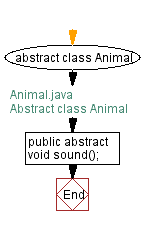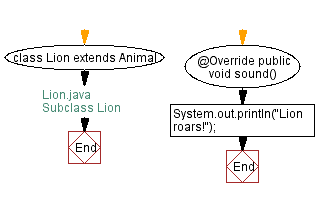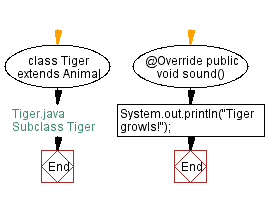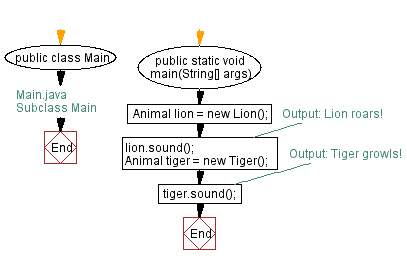Java Abstract Classes - Abstract Animal Class with Lion and Tiger Subclasses
Write a Java program to create an abstract class Animal with an abstract method called sound(). Create subclasses Lion and Tiger that extend the Animal class and implement the sound() method to make a specific sound for each animal.
Above exercise represents the class structure and the relationship between the abstract class and its subclasses.
In the following code, the Animal class is shown as an abstract class with the abstract method sound(). The Lion and Tiger classes are subclasses of Animal and provide their own sound() implementations. The arrow indicates the inheritance relationship, where Lion and Tiger inherit from Animal.
Sample Solution:
Java Code:
// Animal.java
// Define an abstract class named Animal
abstract class Animal {
// Declare an abstract method named sound
public abstract void sound();
}
The above code defines an abstract class named Animal. An abstract class is a class that cannot be instantiated on its own and must be subclassed. The Animal class contains an abstract method named sound(), which means any subclass of Animal must provide an implementation for the sound() method. Here is a brief explanation of each part:
- abstract class Animal: This line defines an abstract class called Animal.
- public abstract void sound();: This line declares an abstract method named sound that must be implemented by any concrete subclass of Animal.
// Lion.java
// Define a subclass named Lion that extends Animal
class Lion extends Animal {
// Override the abstract method sound from the Animal class
@Override
public void sound() {
// Print "Lion roars!" to the console
System.out.println("Lion roars!");
}
}
The above code defines a subclass named Lion that extends the abstract class Animal. The Lion class provides an implementation for the abstract method sound() defined in the Animal class. Here's a brief explanation of each part:
- class Lion extends Animal: This line declares that Lion is a subclass of Animal.
- @Override: This annotation indicates that the following method overrides a method declared in a superclass.
- public void sound(): This line defines the implementation of the abstract method sound() from the Animal class.
- System.out.println("Lion roars!");: This line prints "Lion roars!" to the console, providing the specific behavior for the Lion class.
// Tiger.java
// Define a subclass named Tiger that extends Animal
class Tiger extends Animal {
// Override the abstract method sound from the Animal class
@Override
public void sound() {
// Print "Tiger growls!" to the console
System.out.println("Tiger growls!");
}
}
The above code defines a subclass named Tiger that extends the abstract class Animal. The Tiger class provides an implementation for the abstract method sound() defined in the Animal class. Here's a brief explanation of each part:
- class Tiger extends Animal: Declares that Tiger is a subclass of Animal.
- @Override: Indicates that the following method overrides a method declared in a superclass.
- public void sound(): Defines the implementation of the abstract method sound() from the Animal class.
- System.out.println("Tiger growls!");: Prints "Tiger growls!" to the console, providing the specific behavior for the Tiger class.
// Main.java
// Define the Main class
public class Main {
// Main method to run the program
public static void main(String[] args) {
// Create an instance of Lion and assign it to an Animal reference
Animal lion = new Lion();
// Call the sound method on the Lion instance
lion.sound(); // Output: Lion roars!
// Create an instance of Tiger and assign it to an Animal reference
Animal tiger = new Tiger();
// Call the sound method on the Tiger instance
tiger.sound(); // Output: Tiger growls!
}
}
Output:
Lion roars! Tiger growls!
Flowchart:




For more Practice: Solve these Related Problems:
- Write a Java program where the "Lion" subclass includes a method to display its hunting behavior.
- Write a Java program where the "Tiger" subclass adds an attribute for stripe count and a method to display it.
- Write a Java program where the "Animal" class includes an attribute for habitat, and subclasses define specific habitats.
- Write a Java program where the "Animal" class has a lifespan attribute, and subclasses override it based on species.
Go to:
Java Code Editor:
Contribute your code and comments through Disqus.
Previous: Java Abstract Classes Exercises Home.
Next: Abstract Shape Class with Circle and Triangle Subclasses.
What is the difficulty level of this exercise?
